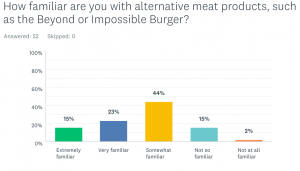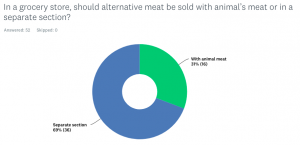Beyond the Burger: Alternative Meats
Olivia Shoemaker
A radical solution
I glanced skeptically to my roommate after the first bite. The soy-based Worthington XBurger claimed to “look, cook and satisfy just like a beef burger” when in reality, it tasted entirely manufactured. The exterior could’ve fooled most, but the essence was undoubtedly abnormal. Being a pescatarian myself and maintaining a diet bereft of beef, I was excited to try a quasi-burger for the first time in months. I didn’t usually long for a cheeseburger since my commitment to greener eating, but had often missed out on shared meals like Thanksgiving turkey and family favorites at the dinner table. The XBurger surely wasn’t going to solve these problems, but the option was nothing if not suggestive of a potential future that included meat without all the concerns that I know others and I share. If those in the same dilemma could become accustomed to the novelty among other factors, then perhaps the XBurger and similar equally imitative products could be the solution that we can trust. Before that point, however, there stands a wall of unknowns between most consumers and that first bite.

As environmental and ethical concerns arise regarding the massive intensive animal farming system, demand is increasing for viable options that support a less meat-heavy diet. While the percentage of the American population that reports maintaining a vegetarian diet has remained relatively stable over the past few decades, the number of people aiming to eat less meat is rising (Judkis). Think meatless Mondays and vegan restaurants. Recently, alternative meats like the XBurger have especially made a name for themselves in the no-meat-eating sphere. Alternative meat encompasses foods that aesthetically resemble meat but do not actually come from an animal, although there are exceptions. Other names include mock meat, plant protein and clever mimicries of the like. The main point being so that those who choose to eat less or no meat do not have to miss out on the unique and arguably tasty characteristics.
Since making an appearance on the food scene, these meat analogs have received a lot of hype both good and bad. The producers and products are touted for their ingenuity and imitation ability. However, much still remains to be determined regarding definition, ethics and nutrition. Some consumers are sold while others still have questions. An anonymous ten-question survey gathered information from 52 respondents regarding their general perceptions of alternative meats and its role in the market. “For some reason they scare me a little. It seems so unnatural; I’m just not sure I’d want to put it in my body.” With the age range varying from under 18 to 65+ and diets from vegan to omnivore, the results were surprisingly varied. The last question gave respondents the chance to share any concluding thoughts. Many commented on cost and brand ethics, while in another question, 79% voted “Environment” as the driving factor that would motivate their purchase of an alternative meat product. One person wrote “My opinion is limited due to not knowing enough” while another wrote “For some reason [alternative meats] scare me a little. It seems so unnatural; I’m just not sure I’d want to put it in my body,” both exemplifying the lack of relevant information made available to consumers.
What are the options?
To adequately discuss alternative meat, we must first break down what our choices are. Most of this stuff comes in the form of a classic beef burger, but you would be surprised by the extent to which some brands have gone. When it comes to talking about mock meat, Beyond Meat and Impossible Foods are two big names currently floating around the market. Even the brand names themselves attest to the limits alternative meat intends to push. Beyond Meat offers an array of meat imitating products ranging from sausage to crumbles, claiming to deliver “the meaty experience you crave without the compromise.” Their website contains an entire subsection dedicated to the ingredients used as well as all 16 partners at which we can find their products. There are 10 options within just five miles of my home here in small-town Indiana alone.

Switch over to Impossible Foods and we see a serious emphasis on meat inclusion. On their website stands brightly colored tag lines and pictures showing consumers the potential to use Impossible Meat on a pizza, tacos, skewers and of course as a burger. There are moving graphics which emulate the sounds and tastes one may hear while cooking meat, and their marketing calls the practice of making meat from animals both prehistoric and destructive. They do not blame the meat, just the current system from which it comes.
JUST is a company that has actually reinvented the process from which our meat normally comes. JUST says they have figured out how to solve “one of the world’s biggest problems,” alluding to the harmful environmental and health impacts of mass meat agribusiness. The company, initially known for their plant-based egg, aims to release a chicken option just like the ones seen at your local butcher’s, without actually killing a single animal. And the technological novelty is astounding. Simply, a cell is harbored from a single feather and that cell is cultured, essentially growing in a specialized plant mixture which imitates the actual animal’s body and resulting in real chicken meat. If it sounds like lab-grown meat, it is. Absurd as it may be, this solution actually ticks a lot of boxes. 69% of those surveyed reported they would try it. Not only could the chicken live its full natural life – this also eliminates the need for colossal swaths of land and precious resource use. As the lines blur between what is meat and what is not, the public and government struggles to mentally and logistically classify these new imitation products.
Excuse me, where can I find the Beyond Burger™?
Eight states have already passed a bill that denies companies like the ones mentioned above the ability to call or market their products as “meat” (Tobin). 17 more states have introduced such laws. They argue consumer deception and misleading labeling even when accompanied by qualifiers like “plant-based” or “meat-free.”

The same argument can be found in the alternative milk industry. Such approaches claim to protect the consumer in the case that meat eaters may accidentally purchase a Beyond Burger™ when in reality they wanted a good ol’ fashioned beef burger. Ideally there is no harm in choosing the non-meat option, but that is not the point. Consumers have a right to know what they are buying. With so much competing information, the responsibility is unfairly placed onto consumers to decide if these alternative meats pass the test or not. Kroger addresses this problem by placing alternative meats in their own freezer section within the vegetarian aisle. Yet friction between government and business hinder us from knowing which side to trust, effectively mystifying meat alternatives even more. While the jury is still out on labeling rights, even more fuss has arisen regarding the health and nutritional aspects of meat substitutes.
The fatty patty
There is no question about the origins of the faux meat that JUST brings to the table, but what is all the other stuff made from? Beyond Meat says their products are built from plants, detailing how each building block of actual meat is imitated with ingredients like natural proteins from peas and fats from coconuts. The impressive absence of GMO, soy and gluten also invites a nod from some in the health community. Though when it comes to the Beyond Burger™, Joan Salge Blake has one problem. Blake, registered dietician and nutrition author, says that the amount of coconut oil used results in consumers eating a quarter of their daily saturated fat limits in just one meal (Laurence). Just one Worthington XBurger patty, the one I tried myself, contained nearly half of the recommended saturated fat daily value.
Impossible Foods takes it a step further during processing and actually utilizes heme, an essential molecule that occurs in every living thing. Their process is tricky and involves genetic engineering to create heme that does not originate from a living being but rather by fermenting soybean yeast. Dana Perls, senior food and agriculture campaigner for environmental advocacy group Friends of the Earth, questions such tactics. She wonders, why put a genetically modified option on the shelves when there are already alternatives that utilize whole-food ingredients? (Laurence). While the ingenuity is impressive and the marketing clever, it remains unclear whether these products are actually healthier or not. This matters to surveyed consumers of which 69% say they would not purchase an alternative meat product if it was less nutritional.
Health implications are further muddled as consumers are left to determine the legitimacy of these plant proteins. The Food and Drug Administration took their time in granting Impossible Foods the right to sell in grocery stores with their concerns mainly stemming from the artificial heme, which is now legally “generally recognized as safe.” They were not granted that right until September of this year (Laurence). JUST is still being worked out in the lab, literally, so there is not much conclusive evidence yet. “I think that alternative meats often pose other issues, like using genetically engineered materials, a lot of soy, or other materials that aren’t necessarily ethical or healthy.” Most health concerns are revolving around the culture used to grow the cells. For the consumer who wants to lower their cholesterol levels or abstain from the dangers of excessive red meat consumption, these are important questions. “I think that alternative meats often pose other issues, like using genetically engineered materials, a lot of soy, or other materials that aren’t necessarily ethical or healthy” wrote one surveyed respondent, illuminating the importance of nutrition even if other problems are alleviated. If the consumer is left in the dark about the health uncertainties, they may switch to alternative meat products without fully considering the potential impacts. Conversely, unfounded vilification of Impossible Burgers and the like may shut out a viable option to many. Unclear health implications are detrimental to the curious and health-driven meat and vegetarian eaters alike.
Before the next bite…
The broadest takeaway is that alt-meat is simply one big question mark to those who are exposed to the teetering reactions of traditionalists and avant-gardes of the like. The intentions seem innocent: no sacrifice must be made for the person who wants to eat meat and remain environmentally conscious at the same time. While it appears on the surface as a nearly perfect solution, there are questions that must still be addressed such as: Can we sell Beyond Meat at the butcher counter or does it get restricted to the minute vegetarian freezer section? Is the taste of meat really worth genetically modifying soybeans? And perhaps most importantly, is all of this stuff really a feasible health option? Ultimately, the fate is in the consumers hands for the plant-based market which is projected to reach sales of $140 billion by the next decade (Crain’s Chicago Business). Not to mention, there are major environmental concerns regarding the amount of energy and technology on which the mock meat industry currently relies. Energy demands necessarily spikes with technological and industrial innovation, but still to a lesser extent than the traditional meat system which is a consoling fact to those concerned with eating green. The overarching implication is that a disconnect exists between the producer, regulator and buyer. Novelty at this scale of biological and social complexity requires time and transparency. If facts like these regarding environment and other topics are not communicated clearly to the consumer, they will be left without a proper toolbelt of important factors when it comes to making the arguably unorthodox switch to meat analogs. Next time I’m in the vegetarian aisle, perhaps I’ll stick with a bean burger.
References
